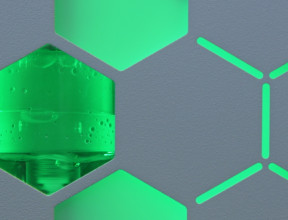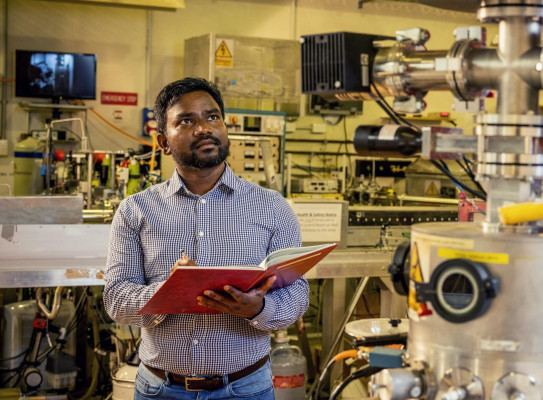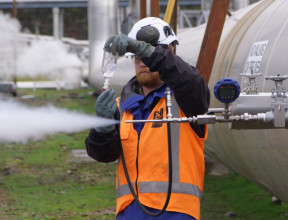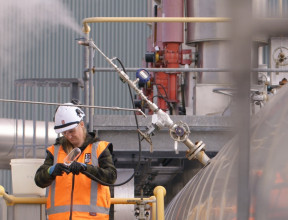
Technologies for a Low-Carbon Future

As part of our Energy Futures theme, Technologies for a Low-Carbon Future sets the long-term direction for our research in energy materials and technology. It also defines the industries and sectors with whom we engage and for whom we co-develop research.
Zero-carbon energy future
Our researchers are working to create, characterise and integrate new materials systems to underpin the clean technologies that will deliver a sustainable and resilient zero-carbon energy future for Aotearoa New Zealand.
Focus areas
The possibilities are limitless, so we have to prioritise where we direct our research efforts. Our current priorities are in carbon upcycling, energy materials development, transforming energy, improving energy efficiency and storing energy.
-
Transforming energy
Energy transformation is the conversion of energy from one type to another, such as in the generation of electricity from kinetic energy or conversion of electricity into a fuel. Enhancing energy transformation can mean increasing yield from existing transformation methods, expanding the range/quality of energy sources that can be transformed and developing new transformation methods. It can also include the upgrading of a form of energy, such as process heat.
Our primary focus in energy transformation is solid-state technologies where there are only solid phase materials throughout the transformation process. These technologies have the benefit of being robust and zero greenhouse gas emissions in use. The conversion efficiency, however, needs to be substantially improved to be competitive with non-solid-state technologies. Examples of solid-state energy conversion materials are photovoltaic, thermoelectric and caloric materials.
-
Improving energy efficiency
Improving energy efficiency means using less energy to achieve the same outcome. Operating more efficiently can reduce emissions, mitigates the need for new energy generation and saves on operating costs.
Our focus in energy efficiency is on material build-up on surfaces over time, including fouling and frost formation. Frosting can occur on finned tube heat exchangers on heat pump and refrigeration units. As frost builds up the efficiency of the system decreases and eventually it must defrost by heating up, which also costs energy. Our technology can change the way frost forms so that it is more conductive, or prevent it from forming at all. Fouling is a build-up of material on the surface of processing equipment. This reduces the heat transfer and therefore lowers the energy efficiency. In food processing, it creates a cleaning requirement that comes at an energy cost. As a result of this, we’re working on solutions to stop food products, such as ice-cream, sticking to equipment.
-
Storing energy
Energy storage is important as we shift to a renewable energy supply. Renewable energy is not on-demand and so energy storage is required to match supply with demand. At GNS Science, we focus on two types of storage: batteries and thermal energy storage.
Batteries store electricity in a chemical form and are an essential part of a renewable electricity system, as well as the electrification of our transport fleet. Our primary focus in batteries is understanding and developing a full lifecycle approach for New Zealand. We aim to have batteries fully reused and recycled safely to minimise waste and our carbon footprint.
Thermal energy storage materials have a high capacity to absorb and release heat at specific temperatures. They can be used to smooth heat demand in industrial processes and passively modulate temperature in buildings to use natural solar heating.
-
Carbon upcycling
To meet the climate target of ensuring global warming does not exceed 1.5°C, we must cut emissions and begin removing carbon dioxide (CO²) from the atmosphere. This will result in a lot of CO² being created. Storing CO² long-term is challenging. An alternative we are exploring is converting CO² into chemicals and ultimately into stable and useful materials. Our focus is on building energy-efficient systems for CO² conversion into simple molecular building blocks. We partner with catalyst researchers in New Zealand and internationally to scale their materials discoveries.
-
Energy materials development
Our energy technologies research is underpinned by a world-class energy materials synthesis and characterisation facility. We specialise in the rapid prototyping of materials to meet the challenging demands of energy systems.
We maintain and continuously improve a suite of ion beam modification and sputtering systems for materials synthesis. To complement this, we have a range of materials characterisation techniques, including ion beam analysis, atomic force microscopy field emissions testing.
We are connected locally and internationally to a full complement of materials simulation, synthesis and testing capabilities, including the MacDiarmid Institute and Australian Synchrotron.
GNS laboratories and facilities include:

